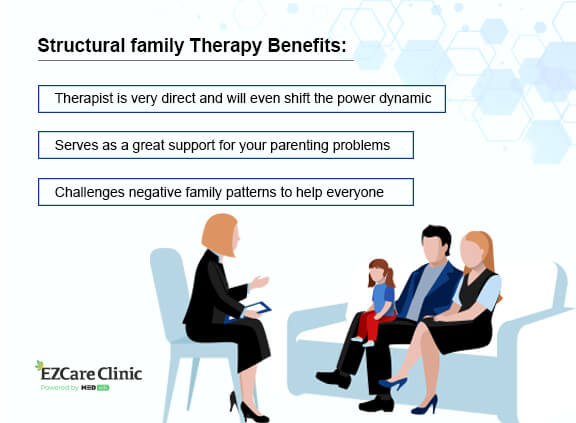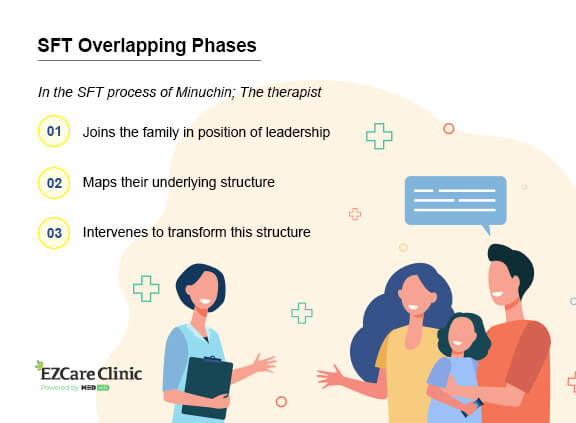Structural Family Therapy (SFT) is a form of family therapy that concentrates on the family unit’s structure and improves relationships and interactions among the family members. According to the proponent of this theory, Salvador Munich, the family members regulate the responses that every member has to both external and internal inputs. The SFT is driven because members of the family unit influence each other mutually when you view family from a systematic standpoint. A change in the behavior of one family member will affect the entire family. Any modification, whether good or bad, brings forth an imbalance.
The imbalance in family systems results in dysfunctionality, which breeds stress and mental health conditions for family members. Most mental health practitioners go back to how family members relate and try to improve the communication and relationship amongst members to reinforce positive behavior change. Several mental problems like depression and anxiety can be treated with positive behavior change.
Get in touch today to connect with the best therapists for your family needs. Click on the button below.
Techniques Used in Structural Family Therapy
Structural Family Therapy uses family mapping techniques to understand behavioral patterns and family relationships. Your therapist will create a visual representation to identify the problems in your family and how to manage issues.
The visual representation is based on the following aspects of the family dynamic:
- Behavioral Patterns
- Family hierarchy
- Family rules
These aspects differ from one family to the other; therefore, you are required to map and describe your family in your own words. The process will give your therapist a clear understanding of your family, and it is also therapeutic to you since you will be able to face the imbalances of your family in a safe place. According to Salvador Munich, having family members participate in the mapping will help create recognition of where these members stand in the family unit, how they belong, and how they affect and influence other family members.
The Joining Technique
In the joining technique, your therapist will create a structure that develops a sharing, compassionate and empathetic relationship in the family. This technique focuses on enabling family members to recognize the weaknesses of other members, step in the gap, and consider other members’ feelings before taking any family-related action.

Role-Playing Techniques
This technique involves active participation by your family members. You and your kin will act out scenarios with the guidance of your therapist. The scenarios are meant to help you, your family, and your therapist recognize behavioral patterns and identity crises and develop working alternatives to help improve the relationship among your family members.
Reframing Technique
The reframing technique aims at helping you and your family view how situations play out from other perspectives. The thought behind this technique is that what might seem like a simple non-issue to you might appear differently to someone else.
Let EZCare professionals help you strengthen the bond with your family members. Book a consultation today!
The Boundary-Making Technique
With this technique, your therapist will help your family recognize and adopt vivid boundaries and hierarchies within the unit. The boundaries will enable members to be informed on what to do and what not to do to other family members.
Boundaries in Structural Family Therapy
The three main boundaries in studying family dynamics are:
- Diffuse or Enmeshed Boundaries
- Rigid or Disengaged Boundaries
- Clear Boundaries
Diffuse Boundaries
Families with diffuse boundaries have little independence amongst the family members, and the members are often overly involved in each others’ lives. The emotional state of each family member depends on the feelings of other members. It is hard to control your personal feelings and emotions in such a situation since the driving force is external.
The Boundary-Making Technique

Rigid Boundaries
Families with rigid boundaries are often broken, and their members are more likely to suffer silently from various mental health conditions like panic attacks, depression, anxiety, and PTSD. Members are isolated from each other, have poor communication skills, and have no respect for each other.
Clear Boundaries
Families with clear boundaries are often families with members who have vital mental health. You will feel comfortable sharing your innermost thoughts and emotions since you and your family members respect each other’s feelings, and there are certain lines you do not cross. Creating clear boundaries facilitates empathy between close kin. The main goal of recognizing boundaries in your family is to establish healthy ones. With healthy boundaries, you will be able to communicate effectively with each other making your relationship strong and stress-free. If you have healthy boundaries at home, you are more likely to transfer that to your place of work and in your social life resulting in a happy life.
At EZCare Clinic, we combine medication with counseling to treat various mental health conditions that prevent you from becoming fruitful in your everyday life. Our qualified and licensed therapists understand family therapy theories such as structural family therapy and use them to get to the root of your conditions. Call us at (415) 966-0848 and set an appointment with us. One of the benefits of collaborating with us is that we can deliver our services online, in the comfort of your home.



